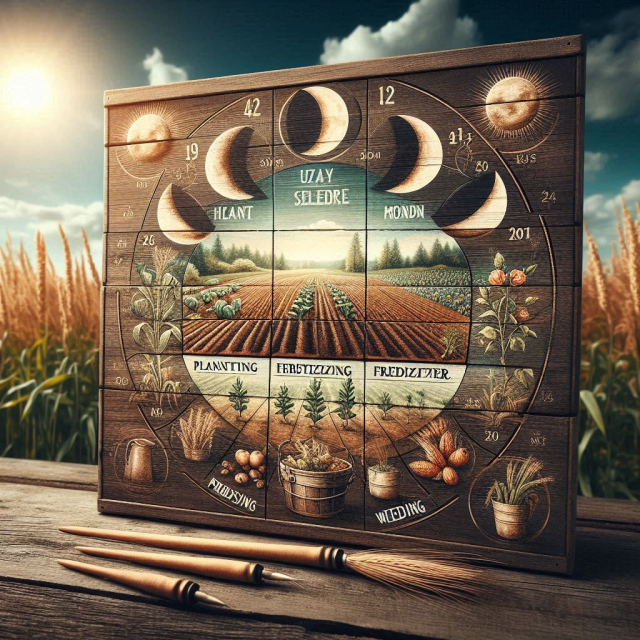The practice of growing according to the lunar phases has been an ancient tradition that has endured over time in various cultures around the world. The belief in the influence of the Moon on plant growth has been passed down from generation to generation, and many contemporary gardeners continue to follow this method to obtain larger and healthier crops. In this extensive article, we will fully explore how to harness the lunar energy in April 2025 to determine the best day to plant and grow in your garden. From the new moon to the full moon and beyond, you'll discover how you can work in harmony with the Moon to improve the health and performance of your plants, as well as practical tips to maximize your success as a gardener.
The Millennial Importance of the Moon in Agriculture.
Since time immemorial, farmers have observed lunar cycles to guide their growing practices. The connection between the Moon and agriculture dates back to ancient civilizations, where rituals and ceremonies were performed to honor the Moon's influence on plant growth. Farmers knew that planting at the right time could make the difference between a bountiful harvest and a mediocre crop. This ancient wisdom has endured through the centuries and continues to be a common practice in traditional and organic agriculture today.
April 2025: A Month of Lunar Renewal.
April 2025 promises to be an exciting month from a lunar perspective, with a variety of phases offering opportunities to connect with celestial energy. Here are the key dates for each lunar phase in April 2025:
New Moon (April 1): Marks the beginning of a new lunar cycle. During this phase, the Moon and Sun are aligned, creating an energy of renewal and potentiality. It is a good time to sow new seeds and establish new plants in your garden.
Waxing Quarter (April 9): During this phase, lunar energy is on the rise. It is a good time to transplant seedlings and promote vigorous growth. Plants have a greater capacity to absorb water and nutrients during this phase, making them more resistant and healthy.
Full Moon (April 17): The full moon is a time of plenitude and culmination. Although planting is traditionally avoided during this phase due to the belief that lunar energy can cause plants to become overly leafy and bolt, some gardeners consider it a good time to harvest herbs and leafy vegetables, as their content of water is higher.
Last Quarter (April 25): During this phase, lunar energy is decreasing. It is a time to perform garden maintenance and prepare for the next planting. It is a good time to prune and fertilize plants, as well as eliminate weeds and pests.
The Best Day to Grow according to the Moon.
Determining the best day to sow and grow in April 2025 requires a deep understanding of the lunar phases and how they affect plant growth. Here are some guidelines to help you plan your planting according to lunar energy:
- Consult a Lunar Calendar: Keep a lunar calendar handy and look for the dates of the lunar phases in April 2025. This will help you plan your planting and growing activities accordingly.
- Observe the Moon Phases: Pay attention to the energy of each lunar phase and how it can affect the growth of your plants. It's always useful to observe how your crops respond to different moon phases and adjust your strategy accordingly.
- Trust your Intuition: If you have a feeling about a particular day, follow your instinct and cultivate at that time. Gardener's intuition is a powerful tool that can help you make informed decisions about when to plant and cultivate in your garden.
Practical Tips for Successful Cultivation.
In addition to planting at the right time, there are several other factors that can influence the success of your garden. Here are some practical tips to maximize your results as a gardener:
- Prepare the Soil: Before planting, make sure the soil is well prepared and enriched with nutrients. Healthy soil is essential to the success of your crops and will provide your plants with the nutrients necessary for healthy growth.
- Plant on New Moon: The new moon is traditionally considered the best time to plant, as it is believed to promote vigorous and healthy growth. During this phase, lunar energy is at its lowest, allowing seeds to germinate and grow quickly.
- Observe Weather Conditions: In addition to the moon phase, it is also important to take local weather conditions into account when planning your growing activities. Avoid planting during periods of extreme weather that may damage your plants.
- Keep a Gardening Journal: Keep track of your growing activities and see how your plants respond to different moon phases. This will help you refine your gardening practices and improve your results over time.
Growing according to the lunar phases is a practice that has been used for generations to promote healthy plant growth and obtain abundant, nutritious harvests. By working in harmony with lunar energy, you can improve the health and yield of your garden and enjoy a larger, healthier harvest. Whether you're planting vegetables, flowers, or herbs, growing at the right time can make a big difference in the success of your crops. May your garden bloom under the luminosity of the Moon in April 2025 and you reap the fruits of conscious and loving sowing.






